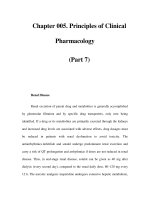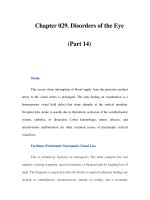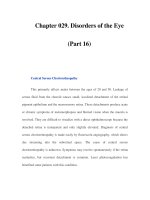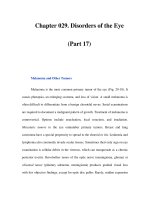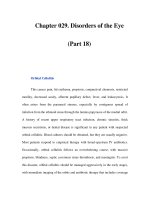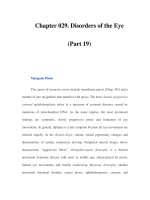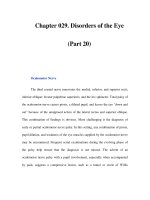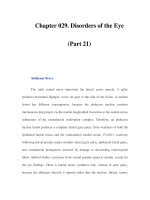Chapter 029. Disorders of the Eye (Part 7) pot
Bạn đang xem bản rút gọn của tài liệu. Xem và tải ngay bản đầy đủ của tài liệu tại đây (14.09 KB, 5 trang )
Chapter 029. Disorders of the Eye
(Part 7)
Allergic Conjunctivitis
This condition is extremely common and often mistaken for infectious
conjunctivitis. Itching, redness, and epiphora are typical. The palpebral
conjunctiva may become hypertropic with giant excrescences called cobblestone
papillae. Irritation from contact lenses or any chronic foreign body can also induce
formation of cobblestone papillae. Atopic conjunctivitis occurs in subjects with
atopic dermatitis or asthma. Symptoms caused by allergic conjunctivitis can be
alleviated with cold compresses, topical vasoconstrictors, antihistamines, and mast
cell stabilizers such as cromolyn sodium. Topical glucocorticoid solutions provide
dramatic relief of immune-mediated forms of conjunctivitis, but their long-term
use is ill-advised because of the complications of glaucoma, cataract, and
secondary infection. Topical nonsteroidal anti-inflammatory agents (NSAIDs)
such as ketorolac tromethamine are a better alternative.
Keratoconjunctivitis Sicca
Also known as dry eye, it produces a burning, foreign-body sensation,
injection, and photophobia. In mild cases the eye appears surprisingly normal, but
tear production measured by wetting of a filter paper (Schirmer strip) is deficient.
A variety of systemic drugs, including antihistaminic, anticholinergic, and
psychotropic medications, result in dry eye by reducing lacrimal secretion.
Disorders that involve the lacrimal gland directly, such as sarcoidosis or Sjögren's
syndrome, also cause dry eye. Patients may develop dry eye after radiation therapy
if the treatment field includes the orbits. Problems with ocular drying are also
common after lesions affecting cranial nerves V or VII. Corneal anesthesia is
particularly dangerous, because the absence of a normal blink reflex exposes the
cornea to injury without pain to warn the patient. Dry eye is managed by frequent
and liberal application of artificial tears and ocular lubricants. In severe cases the
tear puncta can be plugged or cauterized to reduce lacrimal outflow.
Keratitis
This is a threat to vision because of the risk of corneal clouding, scarring,
and perforation. Worldwide, the two leading causes of blindness from keratitis are
trachoma from chlamydial infection and vitamin A deficiency related to
malnutrition. In the United States, contact lenses play a major role in corneal
infection and ulceration. They should not be worn by anyone with an active eye
infection. In evaluating the cornea, it is important to differentiate between a
superficial infection (keratoconjunctivitis) and a deeper, more serious ulcerative
process. The latter is accompanied by greater visual loss, pain, photophobia,
redness, and discharge. Slit-lamp examination shows disruption of the corneal
epithelium, a cloudy infiltrate or abscess in the stroma, and an inflammatory
cellular reaction in the anterior chamber. In severe cases, pus settles at the bottom
of the anterior chamber, giving rise to a hypopyon. Immediate empirical antibiotic
therapy should be initiated after corneal scrapings are obtained for Gram's stain,
Giemsa stain, and cultures. Fortified topical antibiotics are most effective,
supplemented with subconjunctival antibiotics as required. A fungal etiology
should always be considered in the patient with keratitis. Fungal infection is
common in warm humid climates, especially after penetration of the cornea by
plant or vegetable material.
Herpes Simplex
The herpes viruses are a major cause of blindness from keratitis. Most
adults in the United States have serum antibodies to herpes simplex, indicating
prior viral infection (Chap. 172). Primary ocular infection is generally caused by
herpes simplex type 1, rather than type 2. It manifests as a unilateral follicular
blepharoconjunctivitis, easily confused with adenoviral conjunctivitis unless
telltale vesicles appear on the periocular skin or conjunctiva. A dendritic pattern of
corneal epithelial ulceration revealed by fluorescein staining is pathognomonic for
herpes infection but is seen in only a minority of primary infections. Recurrent
ocular infection arises from reactivation of the latent herpes virus. Viral eruption
in the corneal epithelium may result in the characteristic herpes dendrite.
Involvement of the corneal stroma produces edema, vascularization, and
iridocyclitis. Herpes keratitis is treated with topical antiviral agents, cycloplegics,
and oral acyclovir. Topical glucocorticoids are effective in mitigating corneal
scarring but must be used with extreme caution because of the danger of corneal
melting and perforation. Topical glucocorticoids also carry the risk of prolonging
infection and inducing glaucoma.
Herpes Zoster
Herpes zoster from reactivation of latent varicella (chickenpox) virus
causes a dermatomal pattern of painful vesicular dermatitis. Ocular symptoms can
occur after zoster eruption in any branch of the trigeminal nerve but are
particularly common when vesicles form on the nose, reflecting nasociliary (V1)
nerve involvement (Hutchinson's sign). Herpes zoster ophthalmicus produces
corneal dendrites, which can be difficult to distinguish from those seen in herpes
simplex. Stromal keratitis, anterior uveitis, raised intraocular pressure, ocular
motor nerve palsies, acute retinal necrosis, and postherpetic scarring and neuralgia
are other common sequelae. Herpes zoster ophthalmicus is treated with antiviral
agents and cycloplegics. In severe cases, glucocorticoids may be added to prevent
permanent visual loss from corneal scarring.
